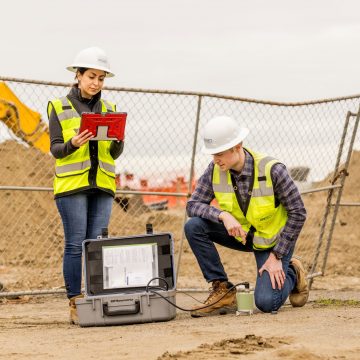The Interdisciplinary Approaches in the Geotechnical Market: Bridging the Void In Between Design, Geology, and Environmental Scientific Research for Ideal Project End Results
The assimilation of engineering, geology, and ecological scientific research within the geotechnical market is not simply useful; it is necessary for accomplishing ideal task results. This interdisciplinary partnership promotes an extensive understanding of complicated site conditions, permitting ingenious solutions to emerge. By analyzing crucial duties and successful situation studies, we can discover the vibrant interplay that drives project success. However, obstacles continue to be in efficiently taking care of these multidisciplinary initiatives, raising questions concerning future trends and potential advancements. What techniques might arise to promote this crucial cooperation and boost the efficiency of geotechnical methods?
Value of Interdisciplinary Partnership
The value of interdisciplinary cooperation in the geotechnical sector can not be overemphasized. Effective geotechnical tasks need the integration of varied knowledge from numerous areas, consisting of design, geology, and environmental science. This cooperation makes sure that all facets of a task are considered, causing comprehensive services that resolve complex difficulties.
Interdisciplinary cooperation fosters technology by enabling experts to share understandings and methods that may not be noticeable when functioning in isolation (consulting engineer). By leveraging the toughness of several techniques, groups can recognize prospective threats, optimize layout processes, and boost the sustainability of geotechnical jobs. Such collaboration promotes an alternative understanding of site-specific problems, which is vital for exact assessment and decision-making.
The intricacy of geotechnical tasks requires a worked with technique to analytical. Eventually, interdisciplinary cooperation is important for advancing best methods and attaining quality in the geotechnical industry.
Trick Roles of Each Discipline
Cooperation among numerous disciplines is not simply helpful; it is vital for the effective execution of geotechnical tasks. Each discipline-- engineering, geology, and environmental scientific research-- plays a distinct yet interconnected role that adds to forecast effectiveness and sustainability.
Geotechnical designers are largely in charge of designing structures and ensuring structural integrity. They assess soil and rock residential or commercial properties to assess load-bearing capabilities, giving important data for risk-free construction techniques. Their experience enables the formulation of ingenious remedies to complex obstacles.

Ecological researchers analyze the possible effects of building and construction on ecosystems and water sources. They carry out ecological analyses and develop reduction strategies to lessen unfavorable effects. By incorporating ecological considerations, they guarantee compliance with regulations and promote sustainability throughout the project lifecycle.
Case Studies of Successful Combination
Successful combination of geotechnical self-controls can be exemplified via numerous case researches that highlight the effectiveness of team effort in attending to complicated design challenges. One remarkable instance is the construction of the Hong Kong-- Zhuhai-- Macau Bridge, where a joint approach including geotechnical design, geology, and ecological science was important. Rock hounds and engineers operated in unison to evaluate the seabed problems and visit this site right here optimize the structure style, making certain security and decreasing ecological effect.
Another impactful instance is the improvement of slope security in the San Francisco Bay Location, where an interdisciplinary team integrated geotechnical analysis with environmental assessments. By incorporating hydrological studies and geological studies, the group efficiently identified potential landslide dangers and carried out effective reduction measures, improving security and sustainability.
Additionally, the redevelopment of Brownfield websites often requires a multidisciplinary technique. In one case in Chicago, partnership among geotechnical engineers, environmental researchers, and city planners caused the effective remediation of polluted soil, allowing for the risk-free published here change of the site into a neighborhood park. These case researches show that interdisciplinary collaboration not only addresses technical obstacles however additionally fosters cutting-edge services that benefit both neighborhoods and tasks.
Challenges in Multidisciplinary Projects

In addition, working with routines and workflows amongst numerous teams can be problematic, especially when each technique has one-of-a-kind task turning points and deliverables. This imbalance can result in hold-ups and boosted costs. The obstacle of resource allowance likewise looms big; making sure that customized know-how is offered at essential points requires cautious preparation and foresight.
Finally, regulative compliance postures one more considerable challenge. Each technique may face different regulative structures, and lining up these needs to fulfill job objectives can be lengthy and intricate. Resolving these challenges requires solid management and efficient communication techniques to cultivate review partnership and ensure that multidisciplinary teams function cohesively in the direction of shared goals.
Future Trends in Geotechnical Practices
As the geotechnical industry progresses, arising fads are reshaping practices to resolve the challenges faced in multidisciplinary jobs - consulting engineer. One substantial fad is the increased combination of advanced technologies, such as fabricated knowledge and artificial intelligence, right into geotechnical evaluation and style. These innovations boost anticipating modeling and risk assessment, allowing engineers to make even more informed choices throughout the task lifecycle

In addition, the adoption of digital doubles and real-time monitoring systems is becoming more prevalent. These devices assist in continuous assessment of soil problems and structural efficiency, permitting for prompt treatments when issues occur.
Final Thought
In final thought, the assimilation of engineering, geology, and ecological scientific research is important for achieving optimal results in the geotechnical market. Effective case studies show the advantages of this technique, while recognizing the difficulties dealt with in multidisciplinary tasks.
The combination of engineering, geology, and ecological scientific research within the geotechnical sector is not just useful; it is imperative for achieving optimum task outcomes. Reliable geotechnical projects call for the integration of diverse proficiency from various fields, consisting of engineering, geology, and environmental scientific research.Browsing the intricacies of multidisciplinary projects in the geotechnical industry presents numerous considerable difficulties.As the geotechnical market advances, emerging trends are improving techniques to attend to the obstacles faced in multidisciplinary jobs. Geotechnical designers are significantly collaborating with environmental scientists to make sure that projects align with sustainability goals and abide with regulatory demands.